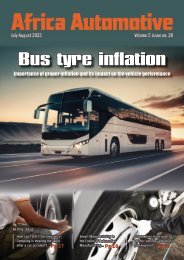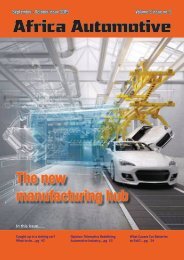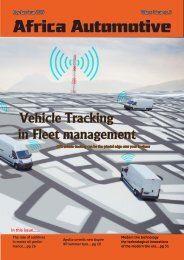Africa Automotive March-April digital issue 2023
Africa Automotive prides itself to be the ONLY Africa’s leading and MOST authoritative magazine for the automotive industry in Africa with printed copies for the automotive industry decision makers in both government, NGO’s and private sector. The Bi-monthly magazine offers cost effective advertising services that get results and improves growth in the auto B2C and B2B sector, keeping an eye on latest technologies in Africa and across the world, the magazine predominately covers the developments in the Africa auto industry.
Africa Automotive prides itself to be the ONLY Africa’s leading and MOST authoritative magazine for the automotive industry in Africa with printed copies for the automotive industry decision makers in both government, NGO’s and private sector. The Bi-monthly magazine offers cost effective advertising services that get results and improves growth in the auto B2C and B2B sector, keeping an eye on latest technologies in Africa and across the world, the magazine predominately covers the developments in the Africa auto industry.
- TAGS
- automotivetyres
- engineoiladditives
- automotiverustremover
- cardealers
- electriccars
- hydrogenpoweredvehicles
- africabusinesssummit
- trucks
- vehiclefinancing
- automotivebatteries
- carmaintenance
- africaautomotivenews
- automotivesuspension
- automotivemanufacturing
- nexusautomotive
- automotiveindustry
- automotiveaftermarket
- automotivemarketing
- africaautomotive
- africa
You also want an ePaper? Increase the reach of your titles
YUMPU automatically turns print PDFs into web optimized ePapers that Google loves.
March-April issue l 2023
Car rust
and formability. However, this added strength comes at a
cost, as it adds impurities that accelerate the formation
of rust.
Exposed steel rusts at different rates depending
on several factors: alloy components, thickness, the
environment the steel lives in, and the type of heat
treating the steel undergoes. Very poorly made cars in
the 1970s began showing surface rust as soon as they
hit the docks. Completely untreated raw sheet steel can
rust through in as little as a few years.
Then there’s the effect of salt. Road salts and other
contaminants dissolved in water act as electrolytes.
When electrolytes are introduced to a chemical reaction,
they speed up the exchange of molecular components.
For drivers, this means that dirty or salty water trapped
somewhere in the car’s body makes that spot rust faster.
It also explains why cars in northern climates where salt
is used in winter as well as cars that spend a lot of time
near the ocean are prone to rot.
This is why automakers do so much to try and prevent
corrosion. A huge amount of testing and material science
is dedicated to keeping your car from dissolving away
beneath you. Aluminum and magnesium components
are becoming popular not only because of their light
weight, but also because they corrode at rates that
are unnoticeable within a human lifetime. However,
those metals are expensive and automakers use them
sparingly as a result.
problem areas are—only then can you save your ride
from its brown, flaky blemishes, keeping your pride and
joy on the road for a long, long time.
Why Do Cars Rust?
Rust forms as a result of the electrochemical breakdown
of iron-based metals. This breakdown is the result
of oxidation, which is the process where iron surface
molecules react with oxygen in the environment and
produce a new molecule, Fe2O3, otherwise known as
iron oxide. That iron oxide is rust.
Pure iron doesn’t oxidize as aggressively. Examine an old
iron engine block and you’ll see a thin surface layer of
rust but little penetration into the metal. Unfortunately,
iron alone isn’t a particularly good material for building
cars, so today’s cars typically use steel alloys. Adding
a dollop of carbon to iron creates steel, which offers
dramatic improvements in flexibility, tensile strength,
Alloying elements added into cars’ steel such as nickel
and chromium can help stave off rust, but nothing is
foolproof—everything eventually corrodes. Modern
sheet steel also comes off the roll with highly durable
coatings. Those are further augmented in the final
assembly plants when freshly made vehicle bodies are
dipped in baths of anti-corrosion agents before the
painting process.
However, the road-facing side of the car turns into one
big sandblasting cabinet at highway speeds, and those
dips and coatings wear off over time. This is why every
car owner needs to periodically inspect their car for rust
regardless of where it lives or what kind of additional
underbody coating it may have come with.
How to Repair Car Rust
Rust forms in stages, and knowing where a problem spot
is in that decomposition process can help point you to
the right solution. Here are the three main stages of rust
and how to fix them.
Surface Rust
The first signs of a problem pop up in paint nicks, cracks,
and scratches. An easy fix.
Surface rust is just that: on the surface. Leave a car with
Africa Automotive News l 2023 35

















